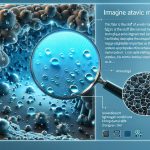Did you know that nanotechnology can enhance fabric strength by up to 50%? You might not realize it, but the clothes you wear could soon be embedded with tiny sensors and electronic components, providing real-time data for various practical uses. Imagine garments that not only last longer but also enhance your athletic performance and monitor your health. There's even potential for these advanced textiles to reduce environmental impact in the textile industry. Curious about how nanotechnology could redefine the very fabric of your daily life?
Table of Contents
Key Takeaways
- Nanotechnology enhances fabric durability by strengthening fibers at the molecular level and incorporating nanofiber coatings for exceptional abrasion resistance.
- Smart textiles embedded with sensors and electronic components provide real-time data, enhancing daily life and offering practical applications.
- Athletic performance fabrics with nanotechnology offer superior moisture management, maintain peak body temperature, and reduce muscle fatigue through compression technology.
- Nanotech fabrics in medical applications improve surgical innovation, infection prevention, and patient recovery rates by monitoring essential signs in real-time.
- Environmentally friendly nanotech fabrics reduce waste, minimize energy consumption, and conserve water resources, making them more sustainable.
Enhancing Durability
Nanotechnology significantly enhances fabric durability by strengthening fibers at the molecular level. Envision your clothes being as resilient as armor yet as cozy as your favorite t-shirt. By incorporating nanofiber coatings, you can achieve exceptional abrasion resistance, guaranteeing your garments endure the test of time and rigorous use.
These coatings are extremely thin, yet they create a sturdy barrier against wear and tear, helping your clothes last longer and appear fresh.
Integrating nanotechnology into wearable technology not only enhances fabric strength; it also heightens impact resistance. Consider sportswear or protective gear that can better absorb shocks and impacts. This implies you'll encounter improved safety without compromising comfort.
The molecular reinforcement offered by nanotechnology ensures that your clothing can withstand more stress and strain, making it perfect for high-performance activities.
Smart Textiles
Smart textiles revolutionize the way you interact with your clothing by embedding advanced sensors and electronic components directly into the fabric. Imagine a shirt that monitors your heart rate or a jacket that adjusts its temperature based on the weather. These aren't futuristic fantasies but realities made possible through wearable technology. Smart textiles seamlessly integrate functionality and fashion, offering you an unparalleled experience.
By infusing fabrics with nanotechnology, the fashion industry is embracing a new era of innovation. Designers and engineers collaborate to create garments that do more than just look good—they enhance your daily life. Picture a business suit that keeps you cool during a meeting or yoga pants that track your movements and improve your form. The possibilities are endless, and the practical applications are already here.
You gain control over your environment and well-being through these intelligent fabrics. Smart textiles can alert you to health issues, connect to other devices, and even provide real-time data. They push the boundaries of what clothing can achieve, merging style with cutting-edge technology. The result? A wardrobe that's not only stylish but also smart, making your life easier and more connected.
Athletic Performance
In the world of athletic performance, nanotechnology-driven fabrics are transforming how you train, compete, and recover. These advanced textiles don't just clothe you; they work with you to enhance every aspect of your athletic endeavors.
Imagine wearing gear that provides superior moisture management, wicking sweat away from your skin to keep you dry and comfortable. With temperature regulation embedded into the fabric, your body stays at the peak temperature, regardless of the external conditions.
Nanotechnology also introduces cutting-edge compression technology that supports your muscles, reducing fatigue and enhancing recovery. This isn't just about feeling good—it's about performing at your best. By improving circulation and reducing muscle oscillation, compression technology ensures that you harness your full potential.
Energy return is another game-changer, where the fabric actually stores and releases energy as you move, giving you that extra push when you need it most.
- Stay Dry: Advanced moisture management keeps you comfortable.
- Peak Temperature: Embedded temperature regulation maintains the right body heat.
- Enhanced Support: Compression technology reduces muscle fatigue.
- Energy Boost: Fabrics that provide energy return to maximize performance.
With these innovations, you're not just keeping up with the competition; you're setting new standards.
Medical Applications
When it comes to medical applications, nanotechnology-driven fabrics are revolutionizing patient care and treatment outcomes. Imagine a world where surgical innovation and infection prevention are greatly enhanced by advanced fabrics. These nanotech fabrics can be integrated into surgical drapes and gowns, reducing the risk of infections and ensuring a sterile environment. This not only elevates patient safety but also improves recovery rates.
Wearable technology is another groundbreaking application. These smart fabrics can monitor essential signs in real-time, providing continuous health monitoring without the need for bulky equipment. Think of the possibilities: patients with chronic conditions can receive timely alerts about their health status, allowing for swift medical interventions.
Here's a glimpse of the emotional impact:
| Benefit | Emotion |
|---|---|
| Reduced infection rates | Relief |
| Improved patient recovery | Hope |
| Real-time health monitoring | Reassurance |
| Timely medical interventions | Security |
| Enhanced surgical outcomes | Confidence |
These advancements in nanotechnology-driven fabrics are more than just technological feats; they're life-changing innovations that promise a healthier future. By mastering these tools, you're not only embracing cutting-edge science but also making a tangible difference in patient lives.
Environmental Impact
Harnessing nanotechnology for fabric production can reduce environmental footprints by minimizing waste and energy consumption. By integrating nanotechnology, you can create fabrics that require fewer resources and generate less waste during manufacturing. This approach not only helps reduce waste but also promotes sustainable production practices, ensuring a greener future for the textile industry.
Nanotechnology allows for the creation of fabrics that are more durable and longer-lasting, which in turn reduces the frequency of replacement and disposal. Additionally, it enables the development of materials that are more efficient regarding energy usage during both production and end-use, such as self-cleaning fabrics that cut down on water and detergent consumption.
Consider these key benefits:
- Reduced Resource Use: Nanotechnology enables the use of fewer raw materials, leading to less environmental strain.
- Enhanced Durability: Longer-lasting fabrics mean fewer textiles end up in landfills.
- Energy Efficiency: Production processes become more energy-efficient, lowering the overall carbon footprint.
- Water Conservation: Self-cleaning fabrics reduce the need for frequent washing, conserving valuable water resources.
Embracing nanotechnology for fabric production isn't just about innovation; it's about paving the way for a more sustainable and responsible industry.
Frequently Asked Questions
How Does Nanotechnology Influence the Colorfastness of Fabrics?
Imagine a fabric that never fades. Nanotechnology enhances colorfastness by boosting stain resistance, durability, UV protection, and breathability. You'll marvel at how your clothes remain vibrant, enduring the elements and daily wear.
What Is the Cost Comparison Between Nano-Enhanced Fabrics and Traditional Fabrics?
When you conduct a cost analysis, nano-enhanced fabrics often cost more than traditional ones. However, market trends show consumers lean towards them due to their superior durability, environmental impact, and evolving consumer preferences for high-performance materials.
Are There Any Potential Health Risks Associated With Wearing Nano-Treated Clothing?
You may face potential health risks with nano-treated clothing, such as allergies and skin reactions. Additionally, the environmental impact and regulatory concerns regarding these fabrics' safety are still being evaluated. Stay informed and cautious.
How Does Nanotechnology Affect the Feel and Comfort of Fabrics?
You'll find that nanotechnology enhances fabric softness and breathability, making your clothes more comfortable. It also improves moisture wicking and durability, ensuring your garments stay dry and last longer, meeting your high standards for performance.
Can Nanotechnology Be Applied to Natural Fibers Like Cotton and Wool?
Absolutely, you can apply nanotech applications to natural fibers like cotton and wool. This integration enhances performance and promotes sustainability, offering improved durability, stain resistance, and moisture-wicking properties without compromising the natural feel.
- Will 100% Cotton Percale Wrinkle? The Honest Truth - July 15, 2025
- Why Do Toenails Tear Percale Sheets and How to Prevent It - July 15, 2025
- Why Is Percale Considered a Superior Sheet? - July 15, 2025







